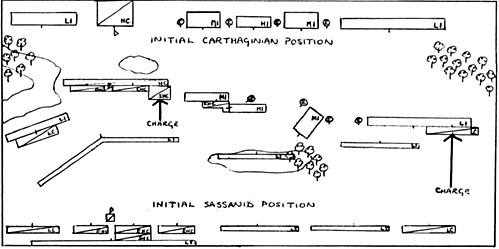Fought at the London Ancient Wargames Club
This battle was a result of a successful Sassanid Persian invasion of Egypt. Driving further west, the vanguard of the conquering Sassanid forces marched 200 miles onwards and 700 years backwards in time to meet a Punic army defending Libya. The ensuing battle took place somewhere on the fertile coastal plain.
The map shows the initial dispositions. From the left, the forces engaged were:
Sassanids
200 light cavalry (spear & bow)
660 clibanarii (kontos & bow)
organised as 3 units of 200 and a General's
bodyguard of 60.
200 cataphracts (kontos) behind
480 light archers behind them
240 light archers
240 light archers
200 light cavalry (spear & bow)
Carthaginians
400 Libyan javelinmen
600 Noble & Phoenician cavalry (spear)
600 Libyan spearmen (long spear)
440 Libyan spearmen (long spear and
captured Roman armour)
600 Libyan spearmen (long spear)
32 elephants behind the spearmen
600 Libyan javelinmen
The battle began with a rapid advance by the Libyan light infantry to secure the flanks of the Carthaginian Army against envelopment. The central phalanx of spearmen supported by elephants rolled ponderously forward, with the cavalry deploying to its right. The Sassanid right wing archers and cavalry hastened to form a skirmish line, while the clibanarii trotted forward with the cataphracts and archers in support and the light cavalry thrown out to their left.
With skirmishing in progress to their right, the clibanarii formed line with the archers in support, facing the enemy cavalry. A quick -volley of arrows heralded their charge, and the Sassanid General led them deep into the enemy ranks. Initially the noble cavalry fought well and even drove the clibanarii back. However class slowly began to tell and the advantage gradually passed to the Sassanids.
During the charge, the right flank regiment of the clibanarii had bumped into the right flank unit of the phalanx and had been disorganised by the supporting elephants. Since then it had been partially engaged with the spearmen. Thus, as the nobles were pressed back, this regiment lost contact and concentrated its efforts on the phalanx. Although outnumbered 5 to 1 after the heavy spearmen attacked in column on the right flank, the clibanarii regiment fought on here doggedly until the end of the battle.
On the extreme right of the Carthaginian forces the Libyan javelinmen continued their relentless advance. They justified their unbeaten record by brushing off re- peated charges by the light cavalry effortlessly. On the Carthaginian left, the light infantry drove the cavalry and archers before them, seeming to be no more affected by arrows than by rain. However, probably as a result of the state of euphoria induced by their rapid advance, the javelinmen suddenly exposed their left flank to an overlap; previously it had been anchored to the wood and/or the edge of the table. One mistake was enough. The Sassanids seized their opportunity and the light cavalry swept forward in a magnificent charge, routing all 600 Libyans and doing fearful execution in pursuit.
In the centre the heavy cavalry of both armies was still hacking away, but the continuing withdrawal of the Carthaginians finally left a significant exposure of their extreme left flank. Tn response to a prearranged signal from the General the cataphract reserve charged home. This proved to be the last straw. The Noble cavalry broke and ran from the field, carrying their General away in the rout. After a brief pursuit, the Sassanid General rallied his pursuing cavalry on the edge of the board only to be prevented from mopping up the leaderless Punic remnants by the onset of dusk. The protracted resistance of the Carthaginian cavalry had enabled 3 of the army to leave the field in good order. The Sassanids bivouacked on the field of victory.
The map shows the position at the moment the final two Sassanid cavalry charges went in.
The battle was fought under 3rd Edition Research Group Rules (slightly modified) with armies of just over 1,100 points each.

Back to Table of Contents -- Wargamer's Newsletter # 133
To Wargamer's Newsletter List of Issues
To MagWeb Master Magazine List
© Copyright 1973 by Donald Featherstone.
This article appears in MagWeb.com (Magazine Web) on the Internet World Wide Web.
Other articles from military history and related magazines are available at http://www.magweb.com